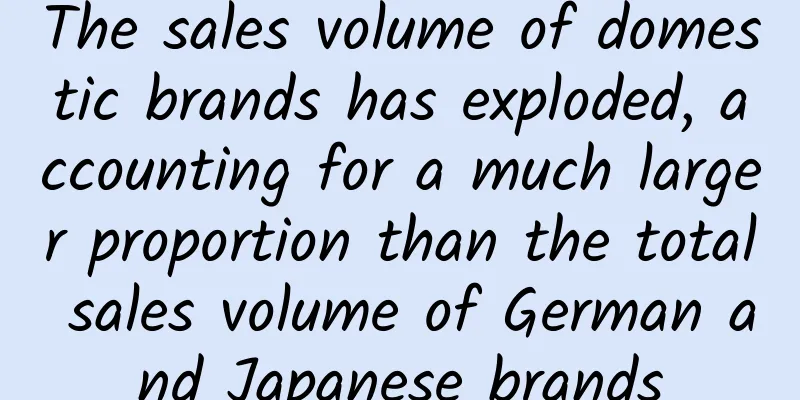The sales volume of domestic brands has exploded, accounting for a much larger proportion than the total sales volume of German and Japanese brands

|
The domestic brand, which had experienced 14 consecutive declines in market share, successfully made a comeback in just two years. The latest sales data shows that in the first 11 months, domestic passenger car sales totaled 21.6781 million units, a year-on-year increase of 15.57%. Among them, domestic brand passenger cars sold a total of 9.2512 million units, a year-on-year increase of 20.18%, accounting for 42.68% of the total passenger car sales, and the market share increased by 1.64% over the same period last year. It is worth noting that as the leading automakers in the first echelon of domestic brands, Changan, Great Wall, and Geely all sold more than 100,000 units in November, becoming the main force to compete with joint venture brands. More than 40% Judging from the sales volume in the first 11 months, German, Japanese, American, Korean and French brands accounted for 19.06%, 15.69%, 12.17%, 7.24% and 2.57% of the total passenger car sales respectively. The domestic brands have a market share of more than 40%, which not only far exceeds the German, Japanese and American brands, but also far exceeds the total share of the former two. Thanks to the launch of domestic SUV models and the increase in sales, domestic automakers' production and sales in November both increased by more than 30% year-on-year, far exceeding the growth rate of joint venture brands, which increased the share of domestic brands to more than 42% in the first 11 months. At present, the first echelon of domestic brands, including Changan, Geely and Great Wall, has a much higher overall sales growth rate than the overall auto market and joint venture brands, and has begun to surpass the second echelon of joint venture brands in sales data. In addition to sales and market share, domestic brands have also made great breakthroughs in quality and price. 100,000 yuan is no longer the ceiling. Aggressive brands have gained a firm foothold in the 150,000 yuan market and are impacting the 180,000 yuan or even 200,000 yuan market. What supports the rise of independent brands is not only the growth in sales figures, but also the actual profit contribution ratio to the profit of independent brands in major automobile groups. In GAC and SAIC, independent brands have not only become the biggest booster of sales and profit growth within the group, but also the biggest profit contributor. In November, the group's independent brands also achieved good results, with the growth rates of SAIC Passenger Cars, GAC, and Dongfeng Passenger Cars reaching 107%, 38%, and 48%, respectively. "After years of accumulation, domestic brands have ushered in the best opportunity for upward breakthrough. Whether from the perspective of customer demand, the capabilities of domestic brands themselves, or accumulation, now is a good time," said Zhu Huarong, vice president of Changan Automobile. The first echelon For a long time, automakers with monthly sales exceeding 100,000 vehicles have been mainly concentrated in joint venture brands, but this situation was broken in the market in November. Judging from the sales data, the overall performance of domestic automakers in November was better than that of joint ventures. The number of domestic automakers with monthly sales exceeding 100,000 vehicles increased from Changan to Changan, Geely and Great Wall. Among them, Great Wall surpassed Changan with a monthly sales of 129,000 vehicles, taking the top spot among domestic brands. Geely became the undisputed dark horse among domestic automakers this year. Not only did its sales in November exceed 100,000 vehicles for the first time, but it was also one of the automakers with the most balanced development of sedans and SUVs. At present, including Emgrand GS, Boyue and Vision SUV are in a state of supply exceeding demand due to production capacity constraints. With the improvement of production capacity next year, these new cars will have greater room for breakthroughs. According to the data from the first 11 months, Changan's cumulative sales have reached 1.168 million vehicles, and the second-place Great Wall has also reached nearly 924,000 vehicles, and it is very likely to exceed 1 million this year. Although Geely currently has only 657,600 vehicles, the industry estimates that its sales may approach 1 million vehicles next year with the launch of new brand models and the latecomer advantage of existing models. However, data previously released by the China Association of Automobile Manufacturers also showed that the sales of domestic brand SUVs in the first 10 months reached 3.93 million units, an increase of nearly 60% year-on-year, becoming the main force driving the overall growth of the domestic brand passenger car market. In the industry's view, over-reliance on a single category is not a long-term solution. Zhong Shi, an automotive industry analyst, said, "The performance of mainstream domestic brand car companies this year is still impressive. The reason is that China's urban SUV market continues to grow, and domestic brands have caught up with this market trend; in comparison, Roewe and Great Wall both rely on urban SUVs to support their performance, while Geely has done the best in terms of category balance, not relying solely on urban SUVs." Policy "tail" If relying on SUV models to walk on one leg poses a long-term risk, then overdrawing on the purchase tax policy is the industry's biggest concern about the recent development of domestic brands. The policy of halving the vehicle purchase tax for passenger cars with a displacement of 1.6 liters or less is about to expire at the end of this year. The generally hot sales of various automakers in November indicate that a "tail effect" has occurred before the policy expires. The industry generally believes that the reason for the surge in sales of domestic automakers is still the rapid growth of the SUV market. On the other hand, the expiring purchase tax preferential policy has overdrawn the market next year to a certain extent. As a result, there are concerns that in the first quarter of next year, as the purchase tax preferential rate is reduced to 7.5%, the auto market may be very bleak or even experience negative growth. It is undeniable that the role of purchase tax incentives in boosting sales of domestic automakers cannot be underestimated. Data from the China Passenger Car Association shows that the proportion of models benefiting from this round of purchase tax incentives has reached 70%. According to the prediction of automakers, this has increased sales by more than 2.2 million vehicles in the overall market. In this process, consumers who buy domestic models are more sensitive to prices. Therefore, preferential policies may be more important for boosting sales of domestic automakers. However, whether it is betting on the SUV market or overdrawing on policies in advance, the domestic brands that have been silent for many years have finally learned to leverage their own strengths. After several years of transformation, upgrading and adjustment, the domestic brands that have bottomed out and rebounded are moving away from the path of winning by simply cost-effectiveness. Whether in traditional power technology or in the face of trendy trends, they have shown their own advantages. The current hotly debated cooperation between Audi and SAIC and the United States' push for the return of manufacturing are the best reminders for Chinese independent brand car companies. In the Chinese market, a market share of more than 40% is just the beginning for independent brands. I believe that a series of independent brand leaders such as Changan, Great Wall, and Geely are ready for the future. As a winner of Toutiao's Qingyun Plan and Baijiahao's Bai+ Plan, the 2019 Baidu Digital Author of the Year, the Baijiahao's Most Popular Author in the Technology Field, the 2019 Sogou Technology and Culture Author, and the 2021 Baijiahao Quarterly Influential Creator, he has won many awards, including the 2013 Sohu Best Industry Media Person, the 2015 China New Media Entrepreneurship Competition Beijing Third Place, the 2015 Guangmang Experience Award, the 2015 China New Media Entrepreneurship Competition Finals Third Place, and the 2018 Baidu Dynamic Annual Powerful Celebrity. |
<<: Audi A3 nitrogen oxide emissions may exceed European standards by double
>>: Are you still missing an ecosystem to become a “great” Internet company?
Recommend
After living on land for a long time, can you return to the ocean to live a "carefree" life?
Produced by: Science Popularization China Author:...
Use it to clean up WeChat and save 10G space in minutes
PC WeChat and mobile WeChat have always been the ...
iOS 14 code exposed, BMW may become the first car manufacturer to support iPhone unlocking
Previously, it was revealed on the Internet that ...
When you are stressed, the changes that happen to your body may be more serious than you think...
Reviewer of this article: Chen Haixu, Deputy Dire...
Why haven't we been destroyed yet?
© Video Hive Leviathan Press: When we expand our ...
Whose nerves were touched by Pechoin’s “high dissemination, low conversion”?
Recently, Pechoin ’s amazing advertisement has se...
Spiders play mahjong? This little spider throws a four-piece card at you!
What is March 14th? White Day? Pi Day? Not only t...
How big is Battlefield 1: What basic website building knowledge do you need to know for website optimization?
As we all know, the carrier of our website optimi...
Call the wind and call the "fish" - "floating" helps offshore wind power to travel across the deep sea!
On October 31, my country's floating wind-fis...
Master these 4 points! Tik Tok search traffic is easily captured!
Do a little survey! If you were born after 85s, 9...
The "small guy" among the great power equipment of a great country - the mobile nuclear power bank "Linglong No. 1" is here!
The world's first commercial modular small re...
A must-read for APP promotion, complete promotion data analysis in 3 steps!
When I was reporting business dynamics to the bos...
How to save the declining OCPC?
If you ask whether oCPC has a decline period, the...
How to monetize short videos on Douyin? A comprehensive review of Douyin's methods of attracting fans and monetizing
Tik Tok is a very popular video platform nowadays...
【Lin Zouxin】Zouxin Academy Portrait Photography Post-production
【Lin Zouxin】Zouxin Academy Portrait Photography P...






![Haagen-Dazs: The magic weapon of store inspection [WeChat corporate account case]](/upload/images/67ebf29041d4f.webp)


